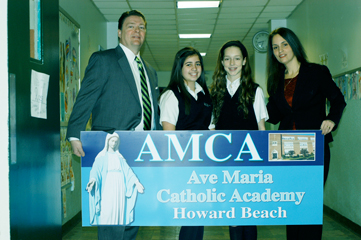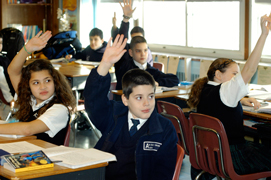by Jay Akasie
This is the second article in a special series on the reconfiguration process in the diocese.

Never tell a determined and talented Catholic community that something can’t be done if they put their minds and resources together to accomplish it.
When the situation looked bleak for Our Lady of Grace School, Howard Beach, declining enrollment and dwindling finances didn’t discourage Principal Maria Cuomo. Instead, she huddled with Father Anthony Rucando, pastor, and Tom Rowland, a school parent and dedicated businessman.
Together, they came up with the best plan to ensure that the Diocese of Brooklyn’s track record for quality Catholic education would flourish in their neighborhood well into the next century.
The old school had an illustrious history, but administrators realized that the changing face of the area meant that they, too, had to be willing to change. In order to attract more students and strengthen the curriculum, they decided to move to an academy model that would tap into ties with the private sector as well as an association with St. John’s University.
The re-named Ave Maria Catholic Academy opened on Sept. 1, 2009, with a re-organized pre-kindergarten through eighth grade school that preserves the former parish school’s high standards for learning, its Catholic identity, and continues to shape the minds of America’s future leaders.
“I think it was a perfect time for the school to forge ahead into this new academy model,” said Cuomo. “The board of directors has collaborated with the administration, faculty and parents to bring improvements to our school.”
This year Ave Maria Catholic Academy is flexing its financial muscle as well. It opened a new science laboratory and is soon to unveil its all-new media center equipped with 20 new laptop computers as well as several desktops, according to Cuomo. “We have also expanded our Italian language program and currently offer the Integrated Algebra 1 Regents Course,” she said.
One of the greatest benefits from becoming an academy, according to Cuomo, is the partnership Ave Maria has made with St. John’s University. The university provides guidance and resources to both the board of directors and administration. “Their knowledge and expertise in the field of education cannot be taken for granted. We are so thankful for their commitment to Ave Maria Catholic Academy,” she said.
The Superintendent of Schools for the Diocese of Brooklyn, Dr. Thomas Chadzutko, said that Ave Maria serves as the perfect demonstration as to why the academy can be the right educational model for Catholic schools of the future.
The academy paradigm is advantageous, he explained, because it brings people to the board of directors with levels of expertise like finance, marketing, and recruitment — professional backgrounds that are not often involved with school boards. Plus, the academy is an incorporated entity that’s separate from the parish. “That allows us to seek funding and grants that religious organizations don’t always enjoy because of former connections to a parish,” said Dr. Chadzutko.
Ave Maria was able to utilize these advantages to lower tuition and to hire more teachers – something for which the old parish school model did not allow. One of the biggest challenges that Catholic schools in Brooklyn and Queens now face is that many of them were created more than a century ago, when inner-city parishes bustling with families packed students into the classrooms. Demand for Catholic education was high and the cost was low.
They were parish schools, staffed largely by nuns, and almost every church had one. But the demographics of Brooklyn and Queens changed. By the 1970s, the diocese faced the challenge of maintaining large physical plants and dwindling enrollments. More families were moving to the suburbs.
The lion’s share of the current diocesan reorganization plan – Christ Jesus, Our Hope — involves identifying which parishes can operate best when merged into another parish nearby.
One of the little known aspects of these parish mergers is that schools that are often attached to the parish continue to operate after the merger. Parishes are now being asked to reorganize their schools into strong, prominent Catholic academies that are suited to the needs of 21st-century families.
Such success stories like Ave Maria and others bode well for the future of Catholic education in Brooklyn and Queens. “We’re thinking about regional planning issues. These new academies ensure that entire neighborhoods won’t be lacking a Catholic school,” said Dr. Chadzutko.

The foresight to convert Catholic schools into Catholic academies is bucking the sad trend nationwide of sterling parochial schools having to shut their doors because of dwindling funds and admissions. A recent study by Loyola Marymount University found that Catholic schools nationwide graduate 98% of their students and send most of them to college.
Despite that record of excellence, nationwide there are 6,900 Catholic schools with two million students. In 1960, there were more than 13,000 Catholic schools with a combined enrollment of 5.5 million students. That’s a drop in nationwide enrollment by more than two-thirds.
A professor of education at the Catholic University of America, John Convey, has overseen 16 studies of diocesan school systems across America since 1983, including one such study for the Diocese of Brooklyn. What he found was that parents are more critical than ever of getting what they perceive to be the best value for their educational dollar. Professor Convey also found that many parents place a premium on Catholic teaching and doctrine in the face of crass secularism that can erode the mind and character of a young child.
“What makes a good Catholic school is a strong community that surrounds the school, high academic standards, high expectations for all students, and a sense of commitment on the part of teachers,” said Convey. “Catholic school teachers have a very strong sense of commitment to the mission of the school and that makes them very effective.”
Indeed, at Ave Maria one of the biggest challenges to the reorganization was the sense of disconnect between Ave Maria Catholic Academy and the alumni that graduated from the school’s predecessor, Our Lady of Grace School, explained Cuomo. But the new academy is still very connected to Our Lady of Grace parish, she said, with students attending weekly Mass, and with the pastor, Father Rucando, teaching a weekly religion class to grades two through eight. “Our Catholic identity remains strong,” said Cuomo.
Salve Regina Catholic Academy on Jerome St. in East New York opened last month for the first time. (See story on Page 6.) It combined the teaching staffs and resources of the parish schools of St. Rita’s, St. Michael’s, and St. Sylvester’s. Enrollment is now bustling with more than 730 students.
Across town, St. Catherine of Genoa, East Flatbush, was faced with a similar dilemma: how to maintain its high standards and to continue teaching students to live out the Gospel in whatever they endeavor to do. The solution was to work with nearby St. Therese of Lisieux Church and to consolidate their two parish schools. They chose to locate the new academy at the site of the old St. Therese’s School. Like Salve Regina, St. Catherine of Genoa-St. Therese of Lisieux Academy opened its doors for the first time last month.
Some 350 students in grades one through eight are attending the new academy. Yet the future of both schools used to be a lot more uncertain. Father Charles Odura, the pastor of St. Catherine’s, said that there was nearly a 100% chance that the two schools would have to close. So he and St. Therese’s pastor, Father Hilaire Belizaire, worked with Dr. Chadzutko to come up with an ambitious plan that would save both institutions.
“We just didn’t have the numbers,” said Father Odura. “By coming together, we saved the schools of St. Catherine’s and St. Therese’s. And we were able to pick the best faculty from the two former schools to come over to the new one. So not only do we have a better academic program, but the children are being better cared for.”
Says Superintendent Chadzutko, “Take the successes of these academies, for example. They highlight why the leadership of the laity is critical going forward. Sometimes we can be too, well, parochial, and thinking about Catholic education in this new way will be advantageous to everyone in the long-term.

One thought on “Christ Jesus, Our Hope – Reconfiguration Has Brought New Life to Neighborhood Schools”
You must sign in to leave a comment.